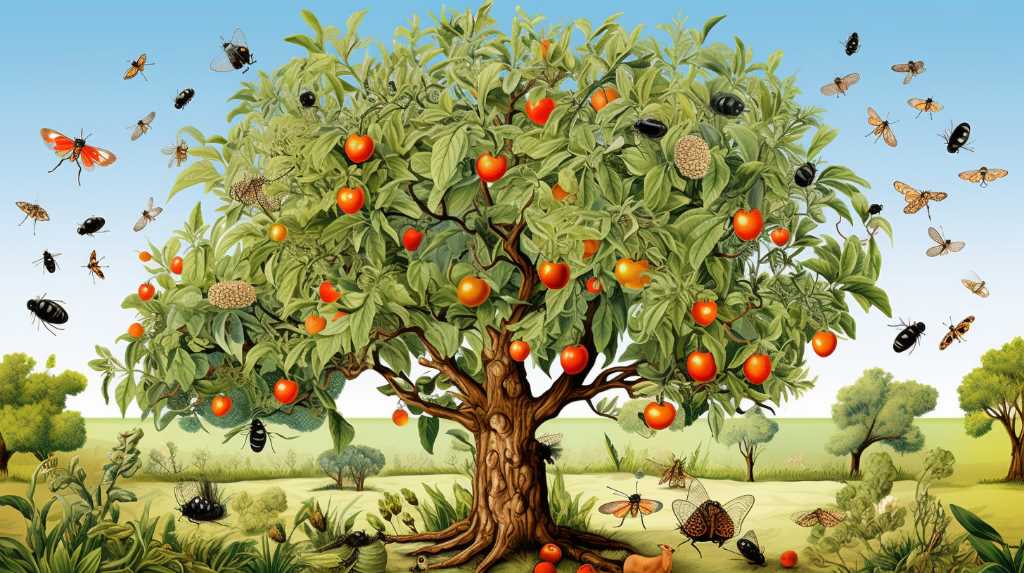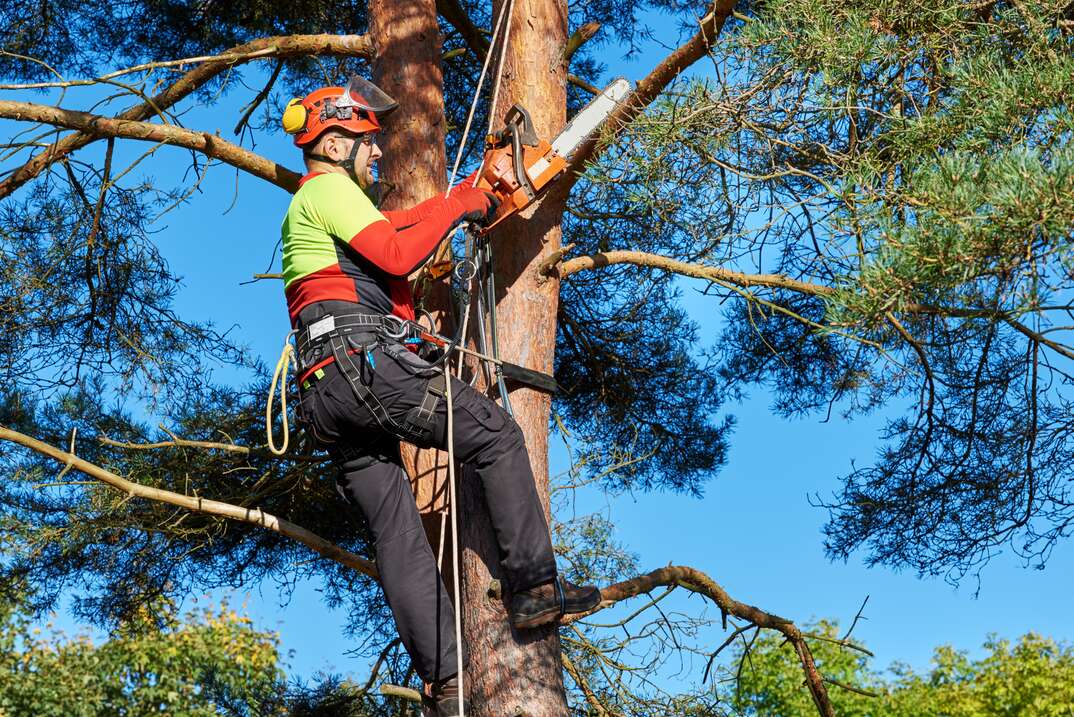Tree Trimming
6 Best Organic Methods for Tree Pest Control


As an expert in tree pest control, I’ve discovered the six best organic methods to keep your trees thriving and pest-free.
Picture this: a garden filled with vibrant, healthy trees that belong in a lush, natural environment.
With the use of neem oil spray, beneficial insects, and pruning infected branches, you can effectively combat pests without harmful chemicals.
Add homemade soap spray, mulching, and natural repellents to your arsenal, and watch your trees flourish in harmony with their surroundings.
Neem Oil Spray
I regularly use a highly effective neem oil spray for controlling pests on my trees.
Neem oil is derived from the seeds of the neem tree, which is native to India. It’s a natural insecticide and fungicide that has been used for centuries in traditional Indian medicine.


Neem oil works by disrupting the life cycle of pests, preventing them from reproducing and causing damage to the trees. It targets a wide range of pests, including aphids, mites, and caterpillars.
The oil coats the insects and suffocates them, while also acting as a repellent. It’s important to apply the neem oil spray evenly and thoroughly, covering all parts of the tree.
This organic method of pest control is safe for beneficial insects, such as bees and ladybugs, which play a crucial role in pollination and natural pest control.
Transitioning into the subsequent section about ‘beneficial insects’, it’s important to consider their role in maintaining a healthy ecosystem.
Beneficial Insects
One of the most effective ways to control tree pests organically is by utilizing the presence of beneficial insects. These insects can provide natural pest control by preying on or parasitizing harmful pests. Here are three types of beneficial insects that can help protect your trees:
- Ladybugs: These small, colorful insects are voracious eaters of aphids, mites, and other soft-bodied pests. They can consume hundreds of pests in a single day, making them excellent natural predators.
- Praying mantises: These unique insects are known for their distinctive appearance and their ability to catch and eat a wide range of insects. They’re particularly effective at controlling pests such as caterpillars, beetles, and flies.
- Lacewings: Lacewing larvae are fierce predators of aphids, mealybugs, and other small insect pests. They’ve a voracious appetite and can quickly reduce pest populations in your trees.
Pruning Infected Branches
To effectively control tree pests organically, it’s crucial to address the issue of pruning infected branches. Pruning is a vital step in tree pest management as it helps remove and manage the presence of pests, such as insects and diseases, while promoting tree health and vigor.
When pruning infected branches, it’s important to identify the affected areas and make clean cuts to remove them. This prevents the spread of pests and diseases to other parts of the tree. It’s recommended to use sharp and sterilized pruning tools to minimize damage and contamination.


Additionally, it’s essential to dispose of the infected branches properly to prevent reinfestation. By pruning infected branches, we can effectively control tree pests and create a healthier environment for our trees.
Now, let’s move on to the next topic: homemade soap spray.
Homemade Soap Spray
I have found homemade soap spray to be an effective method for controlling pests on trees.
This natural pest control method involves mixing water with a mild soap, such as castile soap, and spraying it onto the affected areas of the tree.
The soap works by suffocating the pests, preventing them from feeding and reproducing.
Effectiveness of Soap Spray
After testing various organic methods, I found that soap spray is highly effective for controlling pests on trees. Here are three reasons why soap spray is an excellent option for tree pest control:
- Disruption of Insect Cell Membranes: Soap spray works by disrupting the cell membranes of insects, causing them to dehydrate and die. The soap breaks down the waxy protective layer on the insect’s body, leading to water loss and eventually death. This method is particularly effective against soft-bodied insects like aphids and spider mites.
- Non-Toxic and Environmentally Friendly: Homemade soap spray is made from natural ingredients, making it safe for the environment, beneficial insects, and even humans. Unlike chemical pesticides, soap spray doesn’t leave harmful residues on the tree or in the surrounding ecosystem.
- Easy to Prepare and Apply: Making soap spray at home is simple and cost-effective. All you need is liquid soap, water, and a spray bottle. Mix the ingredients in the correct proportions, and you have an organic pest control solution ready to use. Applying the soap spray is as easy as spraying it directly onto the affected areas of the tree.
Soap spray is an effective, safe, and accessible method for controlling pests on trees. Incorporating this organic solution into your tree care routine can help maintain a healthy and pest-free environment.


Natural Pest Control Methods
An effective natural pest control method for trees is the use of homemade soap spray. Soap spray is a simple and affordable solution that can help eliminate pests without harming the environment or the tree itself.
To make homemade soap spray, you’ll need a mild liquid soap, such as castile soap, and water. Mix one to two tablespoons of soap with one quart of water in a spray bottle. Shake the bottle well to ensure the soap is thoroughly mixed with the water.
When applying the soap spray, make sure to cover all parts of the tree, including the leaves, branches, and trunk. The soap works by suffocating insects and disrupting their cell membranes, effectively killing them.
Regular application of soap spray can help control common pests like aphids, mites, and scale insects, promoting the overall health of your trees.
Mulching Around the Base
To effectively control tree pests organically, one must begin by mulching around the base using a layer of organic material. Mulching provides several benefits that help protect trees from pest infestations:
- Moisture retention: Mulch acts as a barrier, reducing evaporation and retaining moisture in the soil. This helps to keep the tree roots hydrated and healthy, making them less susceptible to pest damage.
- Temperature regulation: Organic mulch insulates the soil, preventing extreme temperature fluctuations. This creates a more stable environment for the tree, discouraging pests that thrive in hot or cold conditions.
- Weed suppression: Mulch helps to suppress weed growth around the base of the tree. Weeds can attract pests and compete with the tree for nutrients. By keeping weeds at bay, mulching reduces the risk of pest infestation and promotes the tree’s overall health.
By implementing mulching as a preventive measure, we can create an environment that discourages pests and promotes the well-being of our trees.
In the subsequent section, we’ll explore natural repellents that provide additional protection against tree pests.


Natural Repellents
I use natural repellents to protect my trees from pests.
Natural repellents are a safe and effective way to deter pests without harming the environment or the trees themselves.
One common natural repellent is garlic spray. By diluting garlic cloves in water and spraying the mixture onto the trees, the strong odor repels pests such as aphids, mites, and beetles.
Another effective natural repellent is neem oil. Neem oil contains compounds that disrupt the life cycle of many pests, preventing them from feeding and reproducing.
It’s important to apply natural repellents regularly, especially after rainfall, to ensure continued protection.
Natural repellents are a sustainable and eco-friendly solution for keeping pests away from your trees, promoting their health and longevity.


Hello there! I’m Logan Foster, the green-thumbed social media marketer behind the vibrant world of 1800TreeGuy.com. With roots firmly planted in arboriculture, I’ve branched out to help clients cultivate their dream outdoor spaces, one leafy canopy at a time. My knack for nurturing nature is more than a profession—it’s a way of life.
When I’m not talking trees and teaching the art of arboreal care, you can find me cheering on the Bulldogs—my alma mater’s pride and my forever team. My environmental studies there didn’t just teach me about ecosystems; they instilled a lifelong passion for protecting our planet.
Off the clock, I’m an adventurer at heart. Whether it’s trekking the Appalachian trails, pedaling down a mountain path, or crafting guides to share the wonders of the wild, I’m happiest with soil under my nails and the sun on my face. And let’s not forget Yoda, my pug sidekick. He may not have mastered the art of stillness, but his joyful grins are my daily dose of happiness.
I’m all about making connections—between people and the great outdoors and between my clients and their ideal landscape visions. My approach is personal; every tree has a story, and every garden reflects its caretaker.
If you want to green your scene or share in my outdoor escapades, give me a shout on Instagram or Facebook. Let’s cultivate a conversation and grow a community rooted in a love for the lush life.







